Planning a trip can be an exciting yet daunting task. To make it easier, a travel itinerary template is an indispensable tool that can help you organize your plans, save time, and reduce stress. This comprehensive guide will delve into the world of travel itinerary templates, exploring their elements, types, and benefits, and providing tips and best practices for creating and using them effectively.
Introduction
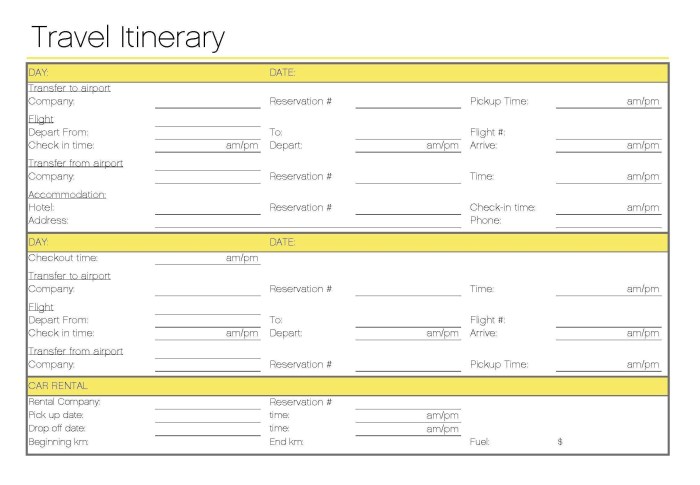
Travel itinerary templates are pre-structured documents that provide a framework for planning and organizing travel arrangements. They typically include sections for essential travel details, such as dates, destinations, accommodation, transportation, and activities.
Using travel itinerary templates offers several benefits. They help travelers:
- Stay organized and keep track of important travel information.
- Plan efficient and well-rounded itineraries that maximize time and resources.
- Share travel plans with others easily.
- Avoid potential travel hiccups by ensuring all necessary arrangements are made in advance.
Elements of a Travel Itinerary Template
An effective travel itinerary template is crucial for organizing and planning a successful trip. It serves as a roadmap for your journey, ensuring a smooth and memorable experience. To create a comprehensive itinerary, it is essential to include the following elements:
Destination and Dates
Clearly state the destination of your trip and the specific dates you will be traveling. This information sets the foundation for the itinerary and helps you determine the logistics of your journey.
When creating a travel itinerary template, it’s important to consider the activities you want to do. If you’re an avid hiker, you’ll want to include some of the best hiking trails in the US on your list. With so many amazing trails to choose from, you’re sure to find one that’s perfect for your skill level and interests.
Once you’ve selected your hikes, you can start planning your itinerary around them.
Transportation
Plan and include details of how you will get to and from your destination. This may involve flights, train rides, or car rentals. Providing specific information about departure and arrival times, as well as any necessary connections, ensures a seamless travel experience.
Accommodation
List the accommodations you have booked for each night of your trip. Include the names of the hotels or guesthouses, their addresses, and contact information. This ensures you have a place to stay throughout your journey and provides a reference point for planning your daily activities.
Activities and Attractions
Determine and list the activities and attractions you plan to visit during your trip. This could include sightseeing tours, museum visits, or outdoor adventures. Include specific details about the locations, operating hours, and any necessary reservations or tickets. This helps you maximize your time and ensures you don’t miss out on key experiences.
Meals
Plan and include your dining arrangements for each day of your trip. This may involve making reservations at restaurants, packing snacks, or researching local eateries. Providing details about mealtimes and locations ensures you have sustenance throughout your journey and allows you to experience the local cuisine.
Budget
Estimate and include a budget for your trip. This involves calculating the costs of transportation, accommodation, activities, meals, and any other expenses. Having a clear understanding of your financial plan helps you stay within your means and avoid unexpected expenses.
Emergency Information
Include important emergency information in your itinerary. This may involve contact details for your embassy or consulate, local police and medical services, and any relevant insurance information. Having this information readily available provides peace of mind and ensures you are prepared for any unexpected situations.
Types of Travel Itinerary Templates
Travel itinerary templates come in various types, each tailored to specific needs and target audiences. Here are some common types:
Personal Itinerary Templates
Designed for individual travelers, personal itinerary templates provide a customizable framework to plan and organize trips. They typically include sections for daily activities, accommodation, transportation, and notes.
Group Itinerary Templates
Suitable for group travel, these templates cater to the needs of multiple travelers. They include features for managing group activities, expenses, and communication, ensuring a smooth and coordinated experience.
Business Travel Itinerary Templates
Specifically designed for business trips, these templates focus on efficiency and professionalism. They include sections for meeting schedules, flight arrangements, hotel accommodations, and expense tracking.
Educational Travel Itinerary Templates
Created for educational purposes, these templates provide a structured approach to planning study tours, field trips, and other educational travel experiences. They often include sections for learning objectives, site visits, and group discussions.
Adventure Travel Itinerary Templates
Tailored to adventure enthusiasts, these templates cater to the unique needs of adventure-based travel. They include sections for activity planning, gear lists, safety protocols, and emergency contact information.
How to Create a Travel Itinerary Template
Creating a travel itinerary template can help you plan and organize your trips more efficiently. Here’s a step-by-step guide to create one:
First, determine the purpose of your template. Consider what information you want to include, such as daily activities, accommodation, transportation, and expenses.
Define Sections
- Start by creating sections for each day of your trip. This will help you visualize your itinerary and ensure you have enough time for all your planned activities.
- Within each day, include sections for transportation, accommodation, activities, and meals.
- You can also create additional sections for notes, expenses, or other relevant information.
Use Tables and Lists
- Tables are a great way to organize information, such as accommodation details or transportation schedules.
- Lists are useful for listing activities, attractions, or restaurants.
Add Flexibility
- Remember to build in some flexibility into your itinerary. Things don’t always go according to plan, so it’s important to have some wiggle room.
- Consider adding extra time for unexpected delays or changes in plans.
Keep it Simple
- Your itinerary should be easy to read and understand.
- Use clear and concise language.
- Avoid overloading your itinerary with too much information.
Using Travel Itinerary Templates
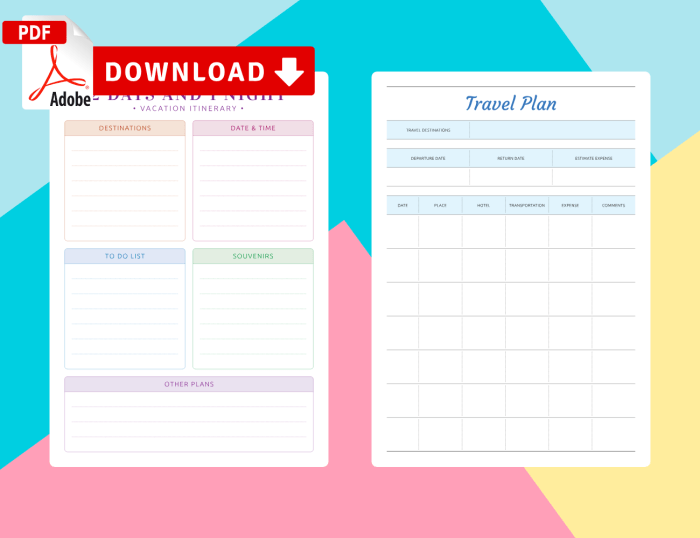
Travel itinerary templates provide a structured framework to plan and organize your trips. Effectively using these templates can enhance your travel experience and ensure a smooth and stress-free journey.
To make the most of travel itinerary templates, consider the following tips:
Customization
Customize the template to suit your specific needs and preferences. Adjust the itinerary to reflect your interests, budget, and travel style. Consider the following aspects:
- Duration: Determine the length of your trip and allocate time accordingly.
- Destinations: Choose destinations that align with your interests and desired experiences.
- Activities: Plan activities that suit your preferences, whether it’s sightseeing, adventure, or relaxation.
- Budget: Set a budget and adjust the itinerary to ensure affordability.
Personalization
Add a personal touch to your itinerary to make it truly unique. Include notes, reminders, and travel hacks that are relevant to you. Consider the following:
- Special interests: Note any specific interests or hobbies you want to incorporate into the itinerary.
- Dietary restrictions: If you have any dietary needs, indicate them in the itinerary for easy reference.
- Packing list: Include a packing list to ensure you bring all necessary items.
- Travel tips: Share any travel tips or recommendations you have learned from previous experiences.
Benefits of Using Travel Itinerary Templates
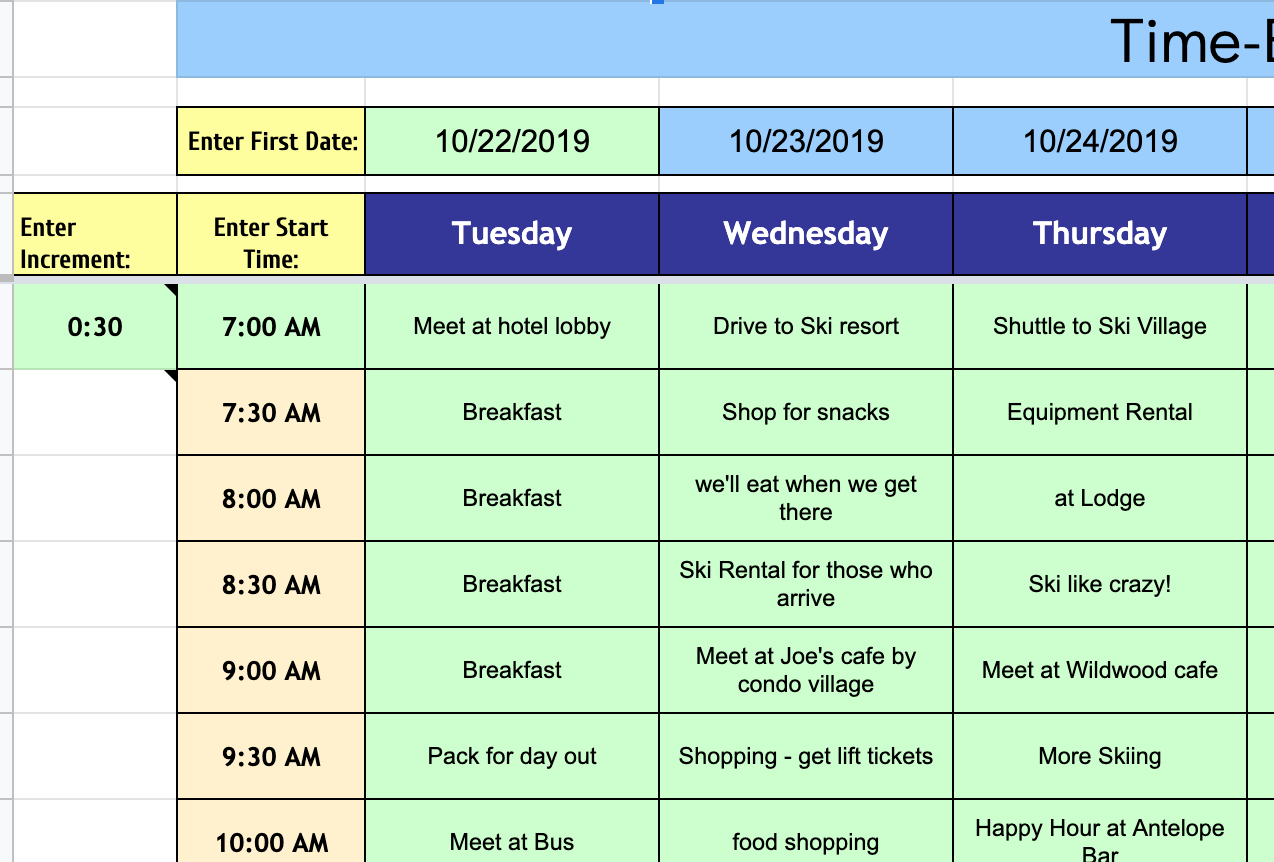
Utilizing travel itinerary templates offers numerous advantages that can greatly enhance your travel experiences. These templates serve as valuable tools, providing significant time savings, reducing stress levels, and ensuring a more organized and enjoyable journey.
One of the primary benefits of using travel itinerary templates is their ability to save you precious time. By providing a pre-structured framework, these templates eliminate the need for manual planning, allowing you to effortlessly organize your trip details. This saves you countless hours of research and planning, enabling you to focus on the more exciting aspects of your travel, such as exploring destinations and creating lasting memories.
After organizing your schedule with a travel itinerary template, it’s essential to consider the items you’ll need for your beach getaway. Refer to a beach holiday packing list to ensure you have everything you need to make the most of your time by the sea.
Once you’ve got your essentials sorted, you can return to your travel itinerary template and continue planning the rest of your trip.
Reduced Stress Levels
Travel itinerary templates also contribute to reduced stress levels by providing a clear roadmap for your trip. With all essential information readily available in one place, you can eliminate the anxiety associated with uncertainty and potential mishaps. Templates help you stay organized and on track, ensuring that you make the most of your time and avoid any unexpected surprises.
Enhanced Travel Experiences
Furthermore, travel itinerary templates facilitate enhanced travel experiences by promoting efficiency and allowing for seamless transitions between destinations. By having a well-planned itinerary, you can optimize your time, ensuring that you visit the most desired attractions and participate in activities that align with your interests. Templates also help you avoid common pitfalls, such as overpacking or missing out on hidden gems, leading to a more fulfilling and memorable travel experience.
Examples of Travel Itinerary Templates
To illustrate the practical application of travel itinerary templates, let’s explore some real-world examples and analyze their strengths and weaknesses.
Crafting a comprehensive travel itinerary template is crucial for any trip, whether it’s a relaxing getaway or an adrenaline-pumping adventure. For those seeking the latter, consider exploring extreme sports vacations. From bungee jumping to skydiving, these experiences offer an unforgettable blend of excitement and exhilaration.
Once you’ve selected your activities, revisit your itinerary template to ensure it accommodates the necessary time and resources for these thrilling pursuits.
Google My Maps
Google My Maps is a versatile tool that allows users to create customized maps and itineraries. It offers a user-friendly interface, integration with Google Maps, and the ability to collaborate with others.
- Strengths: Easy to use, allows for detailed planning, and offers real-time updates.
- Weaknesses: Can be overwhelming for complex itineraries, limited customization options, and potential privacy concerns.
TripIt
TripIt is a popular itinerary management app that automatically consolidates travel plans from email and allows users to organize and share itineraries.
- Strengths: Automates itinerary creation, provides real-time flight updates, and offers a mobile app for easy access.
- Weaknesses: May not always capture all travel details, limited customization options, and subscription-based pricing.
Wanderlog
Wanderlog is a visual itinerary builder that focuses on creating aesthetically pleasing and shareable itineraries. It offers a variety of templates and allows users to add photos and notes.
- Strengths: Beautiful design, easy to share on social media, and provides inspiration for travel planning.
- Weaknesses: Limited functionality, not suitable for complex itineraries, and may require manual entry of travel details.
Advanced Features of Travel Itinerary Templates
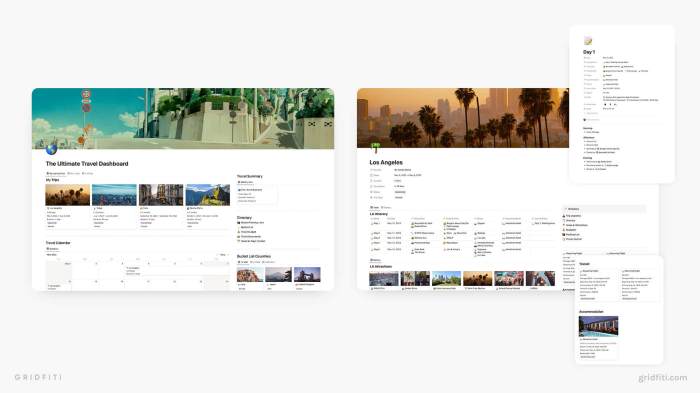
Travel itinerary templates can be enhanced with advanced features that provide users with additional functionality and an improved experience.
These features include:
Interactive Maps
- Interactive maps allow users to visualize their itinerary and get a better understanding of the locations they will be visiting.
- They can also be used to plan transportation routes and find nearby attractions.
Real-Time Updates
- Real-time updates keep users informed of any changes to their itinerary, such as flight delays or cancellations.
- This helps them to stay organized and make necessary adjustments.
Budget Tracking
- Budget tracking features allow users to track their expenses and stay within their budget.
- This helps them to avoid overspending and make informed decisions about their spending.
Collaboration and Sharing
- Collaboration and sharing features allow users to share their itinerary with others and collaborate on planning.
- This is especially useful for group travel or when planning a trip with multiple people.
Voice Control
- Voice control features allow users to interact with their itinerary using voice commands.
- This makes it easier to manage their itinerary and get information while on the go.
Best Practices for Creating Travel Itinerary Templates
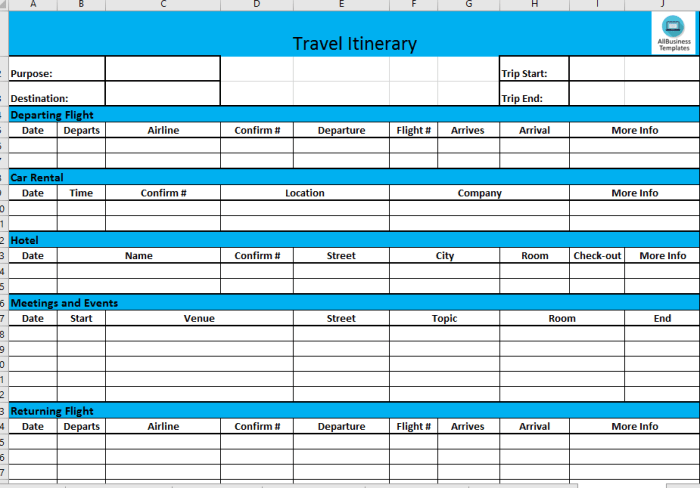
Creating visually appealing and effective travel itinerary templates requires adherence to specific best practices. These include guidelines for typography, color schemes, and layout.
Typography
Select fonts that are legible and easy to read, even on small screens. Consider using sans-serif fonts for headings and serif fonts for body text. Ensure adequate font size and line spacing for readability.
Color Schemes, Travel itinerary template
Choose color schemes that are visually appealing and consistent with the brand or theme of the itinerary. Use complementary colors or monochromatic schemes for a cohesive look. Avoid using too many colors, as it can create visual clutter.
Layout
Organize the itinerary logically, with clear sections for different days or activities. Use headings, subheadings, and bullet points to create a visually appealing and easy-to-follow layout. Consider using icons or images to enhance visual appeal and provide additional information.
Conclusion
In summary, travel itinerary templates provide a structured and organized way to plan and execute your trips. They ensure that you make the most of your time and resources while traveling, reducing stress and enhancing your overall experience.
Whether you’re planning a weekend getaway or an extended adventure, using a travel itinerary template can streamline the process, save you time, and help you create a memorable and enjoyable journey.
Concluding Remarks
In conclusion, travel itinerary templates are invaluable resources for travelers seeking a stress-free and organized travel experience. By incorporating the elements and following the best practices Artikeld in this guide, you can create a tailored itinerary that meets your unique needs and preferences. So, embrace the power of travel itinerary templates and embark on your dream trip with confidence and ease.
Key Questions Answered
What is a travel itinerary template?
A travel itinerary template is a pre-designed framework that provides a structured and organized way to plan and document your travel plans. It typically includes sections for essential details such as destinations, dates, accommodation, transportation, activities, and expenses.
How do I create a travel itinerary template?
Creating a travel itinerary template is easy. Start by determining the essential elements you want to include. Then, choose a template design that aligns with your preferences and needs. Customize the template by adding your travel details, preferences, and any additional sections you deem necessary.
What are the benefits of using a travel itinerary template?
Travel itinerary templates offer numerous benefits, including saving time and reducing stress by providing a structured framework for planning. They help you stay organized, avoid oversights, and ensure a smooth travel experience. Additionally, they can serve as a valuable reference during your trip.